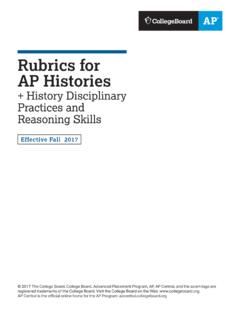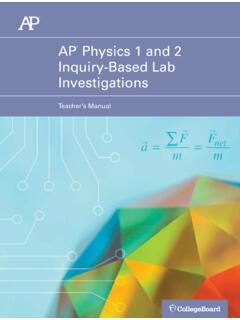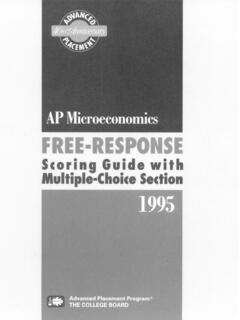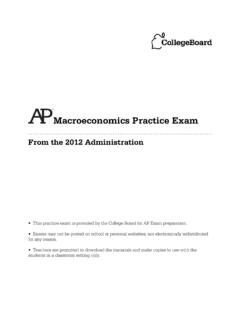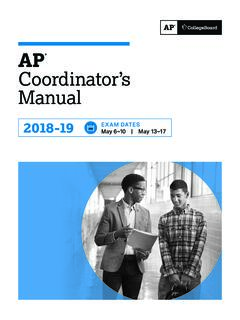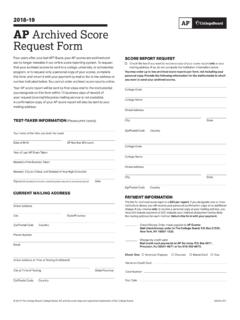Transcription of AP United States History
1 2019AP United States HistorySample Student Responses and Scoring Commentary 2019 The College Board. College Board, Advanced Placement, AP, AP Central, and the acorn logo are registered trademarks of the College Board. Visit the College Board on the web: Central is the official online home for the AP Program: : Short Answer Question 2 RScoring Guideline RStudent Samples RScoring Commentary AP United States History 2019 SCORING GUIDELINES 2019 The College Board. Visit the College Board on the web: Short Answer Question 2 Using the image above, which depicts the first half of the nineteenth century, answer (a), (b), and (c).
2 A) Briefly describe ONE historical perspective expressed in the image. b) Briefly explain how ONE specific event or development in the period from 1800 to 1850 contributed to the process depicted in the image. c) Briefly explain ONE specific historical effect in the period from 1844 to 1890 that resulted from the process depicted in the image. Scoring Guide 0 3 points Score 3 Response accomplishes all three tasks set by the question. Score 2 Response accomplishes two of the tasks set by the question. Score 1 Response accomplishes one of the tasks set by the question. AP United States History 2019 SCORING GUIDELINES 2019 The College Board.
3 Visit the College Board on the web: Short Answer Question 2 (continued) Score 0 Response accomplishes none of the tasks set by the question. Score NR Is completely blank Question-Specific Scoring Guide ONE point for describing ONE historical perspective expressed in the image ONE point for explaining how ONE specific event or development in the period from 1800 to 1850 contributed to the process depicted in the image ONE point for explaining ONE specific historical effect in the period from 1844 to 1890 that resulted from the process depicted in the image Scoring Notes Introductory notes: Each point is earned independently.
4 Accuracy: These rubrics require that students demonstrate historically defensible content knowledge. Given the timed nature of the exam, responses may contain errors that do not detract from their overall quality, as long as the historical content used to advance the argument is accurate. Clarity: Exam responses should be considered first drafts and thus may contain grammatical errors. Those errors will not be counted against a student unless they obscure the successful demonstration of the content knowledge, skills, and practices described below. Examples of responses to (a) that would earn credit: Artist supports Manifest Destiny and the spread of United States settlers westward; image suggests that American civilization is spreading.
5 Image in upper left suggests explorers discovering land that appears to be unoccupied. The image of the wagon train in the center suggests progress and movement of people westward. The image may connote that homesteading and establishing new farms will improve the West. Depiction of American Indians suggests that they are passive observers of United States westward expansion/accepting of United States expansion. The depiction of the sun suggests the light of progress through United States westward expansion (sun is either rising or setting). The image in the lower right depicts people digging for gold in California, which suggests the many ways to profit from westward movements ( , fur trapping, cattle ranching, mining, farming, commercial shipping, trade).
6 All of these views associate Manifest Destiny and the western expansion of the United States with economic progress, social and geographic mobility, religious mission, and ideas of racial superiority. These views also associate Manifest Destiny with white male settlers. AP United States History 2019 SCORING GUIDELINES 2019 The College Board. Visit the College Board on the web: Short Answer Question 2 (continued) Examples of responses to (b) that would earn credit: The Louisiana Purchase added to the territory of the United States that was accessible for national expansion. The War of 1812 and the defeat of Tecumseh s Indian Confederacy opened the Old Northwest to United States settlement.
7 Promotion of the idea of opportunities in the West through the press and by journalists ( , John L. O Sullivan, Horace Greeley) encouraged Americans to move west. Mexican American War and the resulting acquisition of new land by the United States opened new land for United States settlement. Particular population movements into the West contributed to or facilitated westward mobility. o Migration of family farmers for economic opportunity o Emergence of new cities and towns in the West o Oregon Trail allowing for westward movement o Mormon migration o Free-soilers moving to the West Expanded transportation networks ( , canals and railroads) facilitated westward expansion.
8 Economic development of the West encouraged westward migration. o Agricultural staple production in the Midwest o Cotton production and slavery expanding to the West o Growth of the internal slave trade o Fur trade in the Pacific Northwest o Development of extractive industries such as mining o Gold rushes in California and elsewhere o Development of cattle ranching American Indian removal led to the dispossession of land that could then be acquired by western migrants. Examples of responses to (c) that would earn credit: Mexican American War and the resulting acquisition of new land for the United States .
9 Controversies over the spread of slavery to the West, which ultimately led to the Civil War. o Kansas Nebraska Act o Compromise of 1850 o Free Soil Party o Foundation of the Republican Party Developments that contributed to the continuation of population movement into the West between 1844 and 1890. o Migration of family farmers for economic opportunity o Emergence of new cities and towns in the West ( , Chicago) o African American Exoduster migration from the South Expanded transportation networks and greater integration of the West with the economies of the Northeast and Midwest ( , transcontinental railroads).
10 Continued economic development of the West. o Farming on the Great Plains o Largely extractive industries such as mining o Gold rushes in California and elsewhere o Cattle ranching Federal government encouragement of western development ( , Homestead Act, railroad land grants, and subsidies). AP United States History 2019 SCORING GUIDELINES 2019 The College Board. Visit the College Board on the web: Short Answer Question 2 (continued) United States westward expansion created conflicts between white settlers and American Indians. o Wars between federal government and American Indians ( , sand creek massacre (1864), General George Custer s campaigns, Battle of Little Big Horn (1876), Dawes Act (1887), Wounded Knee (1890)) o Forcing of American Indians onto reservations More interest by business leaders in gaining access to and control over external markets in Latin America and beyond.

